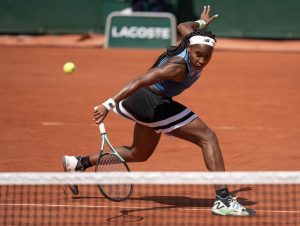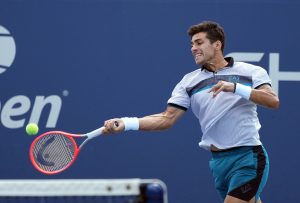Mike Davies might just be the most important figure in tennis history who even tennis fans have never heard of. That is because he wasn’t one of the sport’s great champions, or even one of its greatest broadcasters or writers. Instead, he was an administrator, but he was not just any old administrator. Indeed, he was probably the most important administrator in the history of tennis, who arguably did more than anyone else to usher in the Open (or fully professional) era in 1968. As a result, he was the man who really made modern tennis.
Mike Davies was born in Swansea, in Wales, in January 1936, just six months before the great Fred Perry completed his remarkable hat-trick of Wimbledon titles. Perry, whose eight Major titles (in addition to his Wimbledon hat-trick, he won three US titles and also triumphed once apiece in both Australia and France) still make him Britain’s greatest ever tennis player, was to prove a major influence on the young Mike Davies.
First and foremost, it was Perry, alongside Dan Maskell, a former player, coach and Davis Cup-winning captain who later became “The Voice of Wimbledon” as the BBC’s main tennis commentator, who first identified the teenage Davies as a potentially gifted tennis player. He then helped to accelerate Davies’s development by arranging for him to travel to Australia in the particularly grim post-war British winters, so that he could practise in warm-weather conditions.
However, Perry was also incredibly important to Davies in that he provided the template for what a professional tennis player should be. That was because Perry had ended his own stellar amateur career less than six months after completing his Wimbledon hat-trick, in order to earn his living (and finally make some money from the sport he loved) on the fledgling North American professional circuit. Some three decades later, in the late 1960s, Davies would build upon Perry’s historic decision by helping to turn tennis into a truly professional sport, indeed one that before the coronavirus crisis brought it (and almost everything else) to a halt had arguably become the greatest and most successful individual sport in the world.
However, before those landmark achievements as an administrator and financier of tennis, Davies enjoyed an impressive career as a player. Although he never scaled the heights of Fred Perry by winning the Wimbledon Men’s Singles title (no other British player would do that until Andy Murray, 77 years after Perry’s last Wimbledon triumph), he was still good enough to reach the 1960 Wimbledon Men’s Doubles Final, alongside another Englishman, Bobby Wilson. At a time when almost all the top men’s and women’s singles players competed in doubles as well, Davies and Wilson were a sufficiently powerful pairing to pull off an enormous upset in the quarter-finals, when they knocked out the defending champions, Roy Emerson and Neale Fraser, two of the very best Australian players in the Golden Age of Australian tennis. (Emerson, of course, would hold the record for most Majors won by a man – 12 – until first Pete Sampras and then “The Big Three” of Federer, Nadal and Djokovic passed that mark, while Fraser, having lost in the last eight of the doubles in 1960, went on to win the Men’s Singles title at Wimbledon just a few days later.)
Reaching the Men’s Doubles Final at Wimbledon was to prove the highpoint of Mike Davies’s playing career. Having defeated another all-Australian doubles pairing in the semi-finals (Bob Hewitt and Martin Mulligan, two of the lesser-known Australian stars of the era but who still formed an impressive doubles team), he and Wilson succumbed in the Final to America’s Dennis Ralston and Rafael Osuna, Mexico’s greatest ever tennis player, who would go on to add the 1963 US Singles title to his 1960 Wimbledon Doubles win. In the era before tie-breaks, and when even doubles finals were played out over just three sets (partly to ease the pressure on players who played both singles and doubles), Davies and Wilson lost 7–5, 6–3, 10–8, with the third and final set proving particularly long and arduous. Nevertheless, more than 60 years on, Davies remains the only Welshman to reach any senior Wimbledon Final, although the great rugby player, J.P.R. Williams, who won Junior Wimbledon as a teenager, might have matched or surpassed Davies’s achievements if he had decided to concentrate on tennis rather than rugby.
The 1960 Wimbledon Doubles Final was not only the high-point of Davies’s playing career but effectively marked the end of it, at least as an amateur player (and therefore one who could compete in the sport’s biggest tournaments). Later that year, he joined yet another professional tennis tour in North America. There had been a number of them since Fred Perry’s transatlantic migration in the late 1930s, but none of them had lasted for very long, partly because they were largely starved of the sport’s very best players, who preferred to remain amateur (or at least “shamateur”, or semi-professional) so long as they could continue to compete at Wimbledon, Roland Garros and the other Major tournaments.
However, the professional tour that Davies joined was different to its predecessors in one important way, namely that it was organised and fronted by Jack Kramer, who had been probably the best male tennis player of the immediate post-war era, winning the US title in 1946 and both Wimbledon and the US title in 1947, before he had turned professional. Kramer graduated from playing on the professional tours to eventually running them, and when Mike Davies began playing for him, he proved the ideal man to learn from when it came to running a proper, organised, professional circuit. Indeed, Davies learned so fast and so well that eventually he would eventually replace Kramer as the most important architect of professional tennis, at least on the men’s side of the game. (Billie Jean King, who was both a great champion and a great organiser-activist, deserves that accolade in women’s tennis.)
Davies continued to play professional tennis into the mid-1960s, alongside such genuine stars of the sport as Pancho Gonzalez and Tony Trabert, great players who had won Majors as amateurs before trying to cash in on their fame as professionals. He eventually retired in 1967, but he did so a year early, as the following year Wimbledon and the three other Major tournaments in tennis finally and collectively agreed to allow professional players to enter their fields. As a result, Davies promptly un-retired himself to compete in the first ever Open or fully professional Wimbledon, losing in the first round to America’s Jim Osborne, albeit in a five-set thriller that was a fitting finale to his career as a player. He then promptly retired again, for a second time, and dedicated himself to improving the organisation and administration of the sport he loved.
More than half a century on, it is difficult to fully appreciate the fairly chaotic conditions of men’s (and indeed women’s) tennis in 1968, as it finally became a fully professional sport but without having in place the fully professional set-up to sustain it. That was where Mike Davies came into his own, as he proved himself to be an entirely singular administrator, organiser and financier. Having learned his trade alongside Kramer, he became the executive director of the new World Championship Tennis men’s professional tour, and in those early days there was little that he did not do himself.
On the macro level, Davies obviously organised tournaments, helping to put together the building blocks of the first ever fully professional men’s tour. However, he was also personally involved in selling what was effectively an entirely new sport to television (particularly the all-powerful American television networks), generating sponsorship (at a time when the whole business of sports sponsorship was really just beginning) and even setting up the first association of professional men’s tennis players, the International Professional Tennis Players’ Association (or ITPTA), which eventually became the Association of Tennis Professionals (or ATP), an organisation that Davies would later become the executive director of.
However, Davies was not just a “big-picture” man but also had a command of the details that were to prove so influential in the development of professional tennis. On the micro level, he made a number of individually small but collectively invaluable changes to tennis. In particular, he rethought how it was presented on television, especially the colour television sets that began to sell in huge numbers at the end of the 1960s. He introduced the now ubiquitous yellow tennis balls, as they were much easier to see on television (even older black-and-white sets) than the traditional white balls; after nearly a century of all-white outfits, he brought in coloured clothing, largely to differentiate between players who at the time were relatively unknown to a television audience; and he also organised one-off, indeed unique events, in addition to the regular tour events, such as the 1972 World Tennis Championship Final between two of the greatest tennis players ever, Ken Rosewall and Rod Laver.
Even though both players (and particularly Laver) were probably past their best by that point, the World Tennis Championship Final was still a major ratings winner around the world and especially in America. So successful was it, in fact, that it has been cited as one of the major reasons for the subsequent boom in American tennis in the mid to late 1970s, which was given further impetus by the arrival of two talented but tempestuous champions who were perfect for TV (even if they were as much villains as heroes), Jimmy Connors and John McEnroe.
Davies continued to work in professional tennis, the sport that he had personally been so responsible for creating and certainly for popularising, for the rest of his life, both on the commercial side and on the administrative side, including his stint as executive director of the ATP from 1982 onwards. Within the sport, his enormous contribution has been recognised, for example by his induction into the Tennis Hall of Fame in 2012. But far more importantly, his own setting of the standards required of a newly professionalised sport were followed and built upon by all the major tennis administrators who have followed him, right up to Chris Kermode, the recent head of the ATP who was so controversially ousted (allegedly by Novak Djokovic among others) last year.
The irony is, therefore, that Davies’s biography, which was published in 1961 and just after he had become a professional player, was called Tennis Rebel. By the time he died in 2015, more than five decades later, a more accurate title for a new and revised edition would have been Tennis Emperor, or at the very least The Tennis Empire-Builder. That would have been a much better summation of his impact upon the sport.
Now, as tennis, like every other sport and indeed every other aspect of society, prepares to “reopen” after the coronavirus-caused lockdown that brought it to a halt in March, there is much discussion about its future, in particular the possibility of the ATP and its female equivalent, the Women’s Tennis Association (WTA), joining forces to create a unified professional sport with a unified governing body. But perhaps even more than such a structural change, what tennis in the future might require is another Mike Davies – a tennis lover, and fine tennis player, who became a genuine tennis visionary.
Main Photo:






